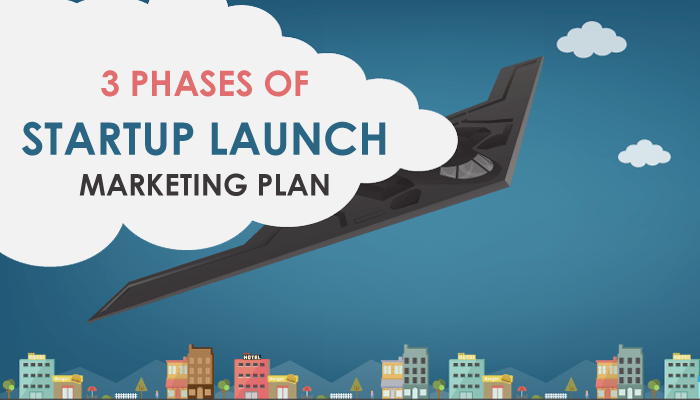The success of a startup would often depend on its approach to marketing plans. With many new startup founders’ struggles with this mind-boggling question, with no prior experience in marketing or handling the marketing budget, it becomes obvious that the marketing deal has become dangerous. The good news is that the startup industry is not short of ideas and it all depends on planning. Learn from old-timers and make sure you have a marketing strategy in place. Launching a startup is an exhilarating journey. The Top 3 Phases of Startup Launch Marketing Plan” is your roadmap to a successful entrance into the market.
The internet is flooded with information, with millions of articles on branding and launch marketing. Reading them all would give you an insight that would help you get started with your launch campaign. Your marketing plan will determine how you are in the market. A warm welcome will give you a head start, boost your motivation and build a name for your brand. To ease out the launch and help you with the marketing preparation, we have jotted down a step-by-step framework for the campaign. We hope this will support your design.
Phase 1 – Strategic Positioning, Brand and Web Presence
1. Strategic positioning
The very first step to successfully launch a brand/product program is to go with the strategic positioning exercise, correct positioning is as important as aiming your tanks in the direction of your target during a war. The initial phase will include by defining the ‘category’ that your product or service does exist within. After categorizing your product/service then jotting down its key benefits, core value propositions and competitor benchmarking. Just after these questions chalk out the segment of people your product or service will cater to, this will also help you in writing down your key messages as you have the profiling of your customers.
2. Brand development
We live in a world with endless competition and branding is everything. Starting from the name of your brand, logo, and URL, you have to stand out from the crowd and really ‘mean something’.
Be creative in your endeavor, you and your business are here for a longer haul, so your brand name and URL should give you the right look and market presence.
If you already have the right look and feel, create a logo that will lure your employees, customers, and partners as well. Give it the right feel and structure.
3. Web Presence
You cannot survive this age without your presence being felt on the web. In the age of social media and digital marketing, your web presence will decide your future. You need to design your website not for yourself but for your customers; think of it as an application that your customers will use to buy your service or product. It should be attractive and at the same time friendly to your customers.
A content-rich blog site, a great Facebook Fan Page and a Twitter page at a minimum. These are the minimum requirements of today’s world.
Technically speaking, you have to embed the most relevant keywords, SEO tags, and visual elements. While planning for the web presence, you have to plan your website according to the onslaught of mobile internet access.
Phase 2 – Blogging, PR, Video and SEO
4. Blog Strategy
In today’s competitive world, no business could survive without a successful blog. Your blog will attract customers to your company and hence they will reach their wallets to buy your product. So don’t be left behind.
Your blog is your marketing front foot; make sure it stands out to you. Blog sites should be set up properly. The blog site should talk about your credentials, key messages, and benefits as well as drive successful thought leadership. Write to yourself or outsourcing, this question needs to be answered. I guess you should hire professional writers because simply that saves your time to invest in something else and also professional writers have the experience to really touch the brain and the heart of the reader.
5. Digital PR and partnering
Get press hits from the activities done by the digital PR and partnering program. This will drive the marketing campaign to a whole new level. Press hits also increase word of mouth (WOM) and online reputation.
Focus on Twitter as the main tool, and of course, effective digital PR and partnering should also give you results by achieving numeric business goals and help drive revenue and clients/users to click to read more
There are also advanced digital PR techniques, such as viral and crowdsourcing communities, that have to be used to increase day-to-day digital PR and partnering mechanisms.
6. Viral videos and guerrilla marketing
Viral videos and guerrilla marketing programs done in a precise way can help amplify and spike awareness. But watch out and be careful about the execution cause if done in a wrong or aggressive way it might backfire.
Be as original as possible, viral videos and guerilla activities are all about great, original ideas, content, and production. These videos’ work and creativity has no limits, remember to add a pinch of humor, it never fails.
7. SEO and link-building
Solid SEO and Link-building must be applied to ensure that your web presence has technical underpinnings and gets effectively amplified by your network dynamics. Just really know how to use the internet for your benefit.
Get solid backlinks from authority sites and email people whose websites are related to your business to provide you with a link to their site. Other strategies would include link-spreading and link-baiting strategies, which should be closely coordinated with digital PR and social media marketing programs.
Keywords are important-research them, develop them; use them in your blogs. This will drive your content and will increase your organic search.
‘Now that you know a great deal more about your brand, product/service, market, prospects, users, clients and partners post launch, you’re in a better position to develop an effective advertising program.’
Phase 3 – Advertising
8. Online Advertising
You positioned yourself in the right direction and have your presence felt in Phase I and \Phase 2. Now Phase 3 is about striking off with some online advertising programs.
Now you have all the vital information about your brand, customer base, category of the service/product, market, prospects, users, clients, and partners, and also your launch is complete. You are in a good strategic position to start your advertising program.
Consider going for the Google Adwords program as it is the best place to start as it is a cost-effective, flexible, results-oriented program. Then slowly start investing in premium services for Facebook ads, and they charge you a minimal amount to run the page for likes.
9. Strategic PR
Digital PR is the basic PR that is done today, to make a difference it requires a few toppings.
PR initiatives to strategically drive events also include high-profile awareness campaigns with large media and high-impact events that can be developed. This way you could easily reach out masses and gain recognition.
This will spread out to high readership, relevant media, critical conferences, and later radio and TV. By and large, this campaign is designed to have a ‘big impact’ on events. This PR is just like the topping on the cake.
10. Crowdsourcing campaigns
Crowdsourcing is another arrow to shoot in the social marketing arena. Big brands and entrepreneurs are tapping into the power of the crowd for contest-based campaign ideas.
Crowdsourcing is also used for cost-effective business development, market research, opinion gathering, customer pledges, and gaining support for your business.
11. Speaking and Briefing
It’s time to take it down the road, and you can do this by developing a program for targeted speaking and analyst/media briefing programs. This will take your brand to a higher level.
Now it’s time to capture the market & lead the arena with thoughts and leadership. Create a position in the market and reach the sky.
Conclusion:
It’s all about making the most out of everything, and with thoughtful and the best shots, you reach the sky. Follow this plan to launch a marketing program for your startup.
Article Written By Andrew Laughlin



